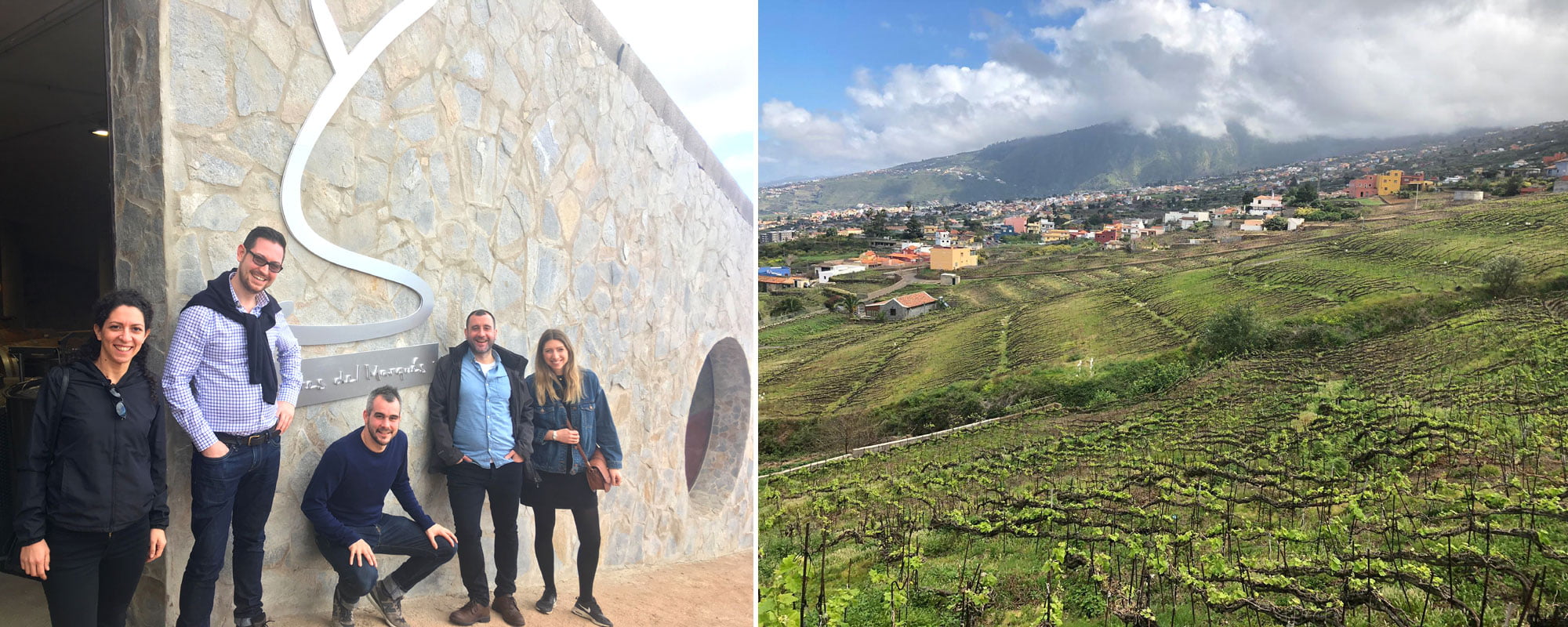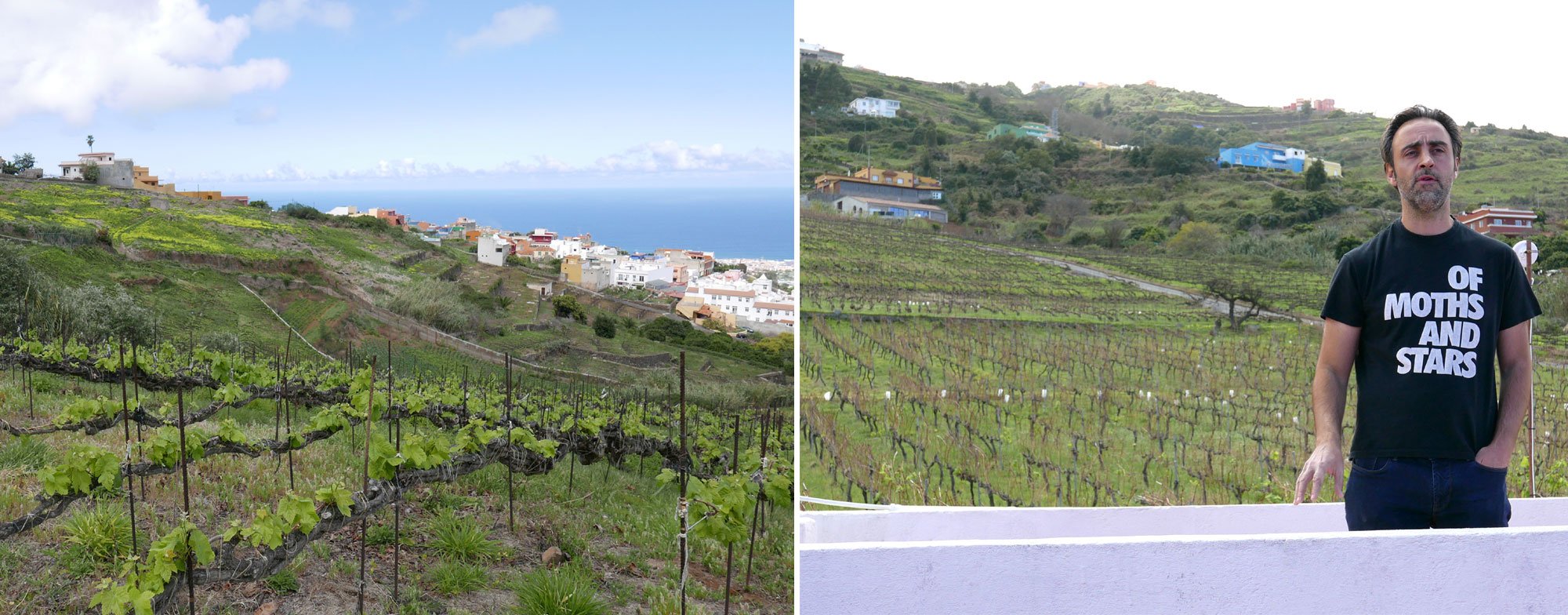
Tenerife is an island of contrasts. Mount Teide at 3,718m dominates, and also defines the climate which is completely different on the north and south sides of the island. The volcano catches clouds that blow in from the Atlantic and this makes the north side of the island much more humid and rainy. The lush green north has a tropical feel with its banana palms and brilliant flowers. The drier south side of the island on the other hand is an arid moonscape, peppered with holiday complexes and theme restaurants. Luckily we were headed for the north to Suertes del Marques to check out their new cellar (pictured above).
Owner Jonatan Garçia Lima is part of the growing breed of intensely passionate producers who are looking to the island’s winemaking heritage, restoring old vineyards and working with lesser known grape varieties. The estate has some incredibly old, low-yielding vines which have to be seen to be believed. The vineyards at Finca El Esquilón are planted on a steep slope of the Orotava Valley. Driving up towards the winery felt like we were strapped into a rocket headed for the stratosphere!
 El Esquilón vineyard with 80 year old Listán Negro. Jonatan welcomes us to the winery.
El Esquilón vineyard with 80 year old Listán Negro. Jonatan welcomes us to the winery.
Jonatan is a natural host, he welcomed everyone and led an eager crowd of wine importers, somms, journalists and winemakers up to a terrace with a birds-eye view of their plots. He started by explaining a bit of the background and history of winemaking on the island. Valle de la Orotava is one of five appellations on Tenerife, the others are Ycoden Daute Isora and Tacoronte-Acentejo in the north and Abona and Valle de Güímar in the south. Vines were originally brought over to Tenerife in the 15th and 16th centuries on boats from Portugal and Spain which stopped at the island on their way to the New World. At that time wines from the region were mainly exported to the UK, Shakespeare mentions ‘Canary wines’ in several of his plays. They had to be fortified to survive the journey.
“There’s a lot of history with Tenerife Wines, winemaking isn’t new to us”.
There is a variety of soils across the Orotava Valley, in the east the soil is clay rich and Listán Negro makes up 95% of plantings. In the west nearer Teide the soil is more volcanic and Listán Blanco makes up 95% of plantings. Soil type also changes as you move down the slopes – red loamy clay in the highest vineyards and paler sandy loam towards the lower sites such as El Ciruelo and El Esquilón at 450-550 metres. Suertes own nine hectares of vineyards and rent a further two. In addition the grapes for 7 Fuentes and El Lance come from plots across the Orotova valley, where Jonatan works with a number of growers. There are hundreds of small plots across the valley, this is due to traditional inheritance laws which split family land equally between sons. The name ‘Suertes’ refers to these little plots of land, individually owned by local families.
The vines on Tenerife are un-grafted, phylloxera didn’t take hold here which Jonatan attributes to their isolation.
“Nobody brought international varietals over here, so phylloxera didn’t make it to the Orotava Valley”.
The thing about the vineyards here that strikes you most is that many of the Suertes vines in the Orotava Valley are grown in a trellising system called Cordon Trenzado. It’s rare, in fact the valley is home to most of the Cordon Trenzado vines in existence. Vine branches are plaited together and supported on stakes, and eventually grow into gnarly arms, sometimes several meters in length.
 Heading down the steep hill past El Esquilón. Close up of one of the plaited arms in Hacienda las Cañas.
Heading down the steep hill past El Esquilón. Close up of one of the plaited arms in Hacienda las Cañas.
There’s a long growing cycle in the valley. The winters aren’t cold so vines wake up early and the summers aren’t really hot up on the hillside so ripening is gradual. Jonatan described it as “Like slow-cooking food”
Jonathan picks relatively early as he is looking for fresh wines with lower alcohols of 11-12%, some grower pick later if they want to make a more powerful style of wine. The majority of organic production around Orotava is managed by Suertes, and when you look at the hillside you can pick out the green plots.
After this introduction we all walked down the steep road and across the top of El Esquilón vineyard, planted with 80 year old Listan Negro. We carried on down the slope ending up in Hacienda las Cañas, the lowest plot at 300-350m. The vineyard is surrounded by palms and orange trees, a heady aroma of orange blossom hung in the air. Originally planted in the 18th century, Suertes rented it for 15 years before the opportunity arose to buy. Las Cañas is planted with Listán Negro, Listán Blanco, Negramoll y Malvasía Rosada. Some of the Listán Negro and Blanco there is 200-250 years old. These are some of the oldest vines in the world. There are also some younger plantings.
“Is cordon trenzado the best training method to use on these vines in the valley?” Jonathan muses, “we’re looking for the best wines we can make with the traditional system we have”.
The soil is rich with a pH of 3.9-4.1 which over time is toxic for vines. Traditionally growers would add lime to the soil to raise the pH which is what Jonatan does as well. He asked one of the retired vineyard workers, who remembered his grandfather adding lime but he didn’t know why. Traditional methods became traditional for a reason.
Jonatan explained a bit about pruning cordon trenzado. If you prune the arms back they’ll grow like cordon royat. You can’t balance yields this way, you need at least four buds. Sometimes four arms come from the same base, and there are productive shoots all along the vines. They prune and tie along the length of the arms, this used to be done individually but now they wrap strings along the arms. There’s a lot of work to be done in his vineyards between pruning and harvest. The arms are staked at intervals to keep them off the ground and then a wire is run along the top of the arms. They train the shoots vertically to this wire to aerate them and avoid botrytis in this humid climate. In two months there will be “walls of leaves along the arms” Jonatan explained.
 Pruning in El Esquilón. Hacienda las Cañas, this plot has some really old Listán Negro and Listán Blanco.
Pruning in El Esquilón. Hacienda las Cañas, this plot has some really old Listán Negro and Listán Blanco.
They get around 600mm of rain per year in the north, in the south it’s more like 60mm. “That’s good for the tourists” commented Jonatan. In the north it’s normal to treat the vines 10-12 times per year that includes low doses of copper for mildew, a bentonite and silicon clay powder for botrytis and a blend of sulphur and cinnamon – which smells really good – for Oidium.
The DO allows yields of 10,000 kg/ha, but Jonatan tends to aim for 6,000 kg/ha which gives the final wines more complexity. Any lower and the wines can be unbalanced.
No cellar opening is complete without a party, in fact Jonatan had organised two! A relatively chilled gathering on Sunday evening for around 300 of his closest friends at his parent’s house in La Orotava. The main event however was the next day, a tasting above the vineyards involving 18 wineries, all friends and favourites of Jonatan from Spain and beyond. It was impossible to get round them all but highlights for me were Cesar Marquez’s Parajes and my first try of his single parcel Sufreiral; Pedro from Guímaro showing the development from village to a single parcel wine from Ribeira Sacra; Alain Graillot’s rich and delicious Crozes-Hermitage La Guiraude; and Ramiro Ibáñez and Willy Perez’s almacenista revival of Bodega de la Riva – that Oloroso… The band started and the tasting flowed seamlessly into party mode.
 Niña Coyote eta Chico Tornado rock the party.
Niña Coyote eta Chico Tornado rock the party.
A huge thank you to Jonatan and his family for inviting us to share this memorable weekend with them. When I spoke to Jonatan in London last June he was really excited about the direction the wines were taking with the support of new winemaker Luis Seabra. You can find more information on all of the Suertes del Marqués wines on our website.

